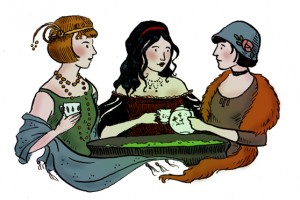 Kirstyn McDermott is the author of the critically acclaimed Madigan Mine and the upcoming Perfections. Her works plumbs the depths of the human (and inhuman) psyche, examining heart and soul with the intensity of a stylish Dr Frankenstein. She joined us by the cauldron (the Lair equivalent of a water cooler) to talk about writing on the side of darkness, hiding under the bed for the purposes of research (and scaring one’s husband), and why the dead deserve company rather than isolation.
Kirstyn McDermott is the author of the critically acclaimed Madigan Mine and the upcoming Perfections. Her works plumbs the depths of the human (and inhuman) psyche, examining heart and soul with the intensity of a stylish Dr Frankenstein. She joined us by the cauldron (the Lair equivalent of a water cooler) to talk about writing on the side of darkness, hiding under the bed for the purposes of research (and scaring one’s husband), and why the dead deserve company rather than isolation.
Dr Angela: What attracts you to the dark side?
This is a question I’ve been asked all my life and one to which I’ve yet to come up with a completely satisfactory answer. But let me try once more.
The superficial part of it is that I really do like scaring people – including myself. The feeling of being scared, or more so the feeling of having attained safety after being in a state of fright, is an undeniably pleasurable experience. Roller coasters, ghost trains, horror movies; you know the drill. To my eternal chagrin, my husband is, for all practical purposes, unscareable. Seriously, I have actually gone to extent of hiding myself beneath our bed one night and reaching out to suddenly grab his ankle, and all he did was frown and ask with a weary and curious tolerance, “Kirstyn, what are you doing down there?” Impossible man! I ask you, what normal person isn’t afraid of monsters beneath the bed?
Ahem. The deeper answer to the question is that I find myself fascinated by the monstrous  – which really boils down to being anything we’re told “normal” people shouldn’t look at or think about or discuss in polite company. Taboo topics. Fringe dwellers. The black in black-and-white. I don’t believe in Evil as a manifest force. I do believe that humans are capable of doing evil things, and that a great number of humans acting in concert are capable of great evil indeed, but what interests me are the underlying reasons, motivations and causes. What makes a human being – someone similar to myself, perhaps – able to commit certain acts that I would find abhorrent, or allow others to commit them? I deeply, deeply want to understand this.
– which really boils down to being anything we’re told “normal” people shouldn’t look at or think about or discuss in polite company. Taboo topics. Fringe dwellers. The black in black-and-white. I don’t believe in Evil as a manifest force. I do believe that humans are capable of doing evil things, and that a great number of humans acting in concert are capable of great evil indeed, but what interests me are the underlying reasons, motivations and causes. What makes a human being – someone similar to myself, perhaps – able to commit certain acts that I would find abhorrent, or allow others to commit them? I deeply, deeply want to understand this.
Dr Lisa: Visual artists and their striking artworks are noticeable features in your fiction: have you dabbled in the fine arts yourself, or is this a passion you explore best in words?
 I studied art through to senior high school and that about as far as my formal education – and possibly my technical skill level! – goes in regards to the visual arts. I used to paint and work with clay a little, and photography is something I love and would love to spend more time with, but not having more time is exactly the problem. So, yeah, writing is pretty much where I expend the vast majority of my creative energy these days.
I studied art through to senior high school and that about as far as my formal education – and possibly my technical skill level! – goes in regards to the visual arts. I used to paint and work with clay a little, and photography is something I love and would love to spend more time with, but not having more time is exactly the problem. So, yeah, writing is pretty much where I expend the vast majority of my creative energy these days.
That said, creativity and obsession and the role of the artist is definitely a major preoccupation in my work, and one of the reasons I often choose to represent this via the visual arts is because – to be blunt – writers writing about writers writing can quickly devolve into a recursive kind of solipsism. Not that it can’t be done well – The Chimney Sweeper’s Boy by Barbara Vine; Misery by Stephen King; Persuasion by A.S. Byatt – but it has been done a lot.
Dr Angela: Tolstoy said all happy families were the same but all unhappy families were  different in their misery – or something like that, hey, he’s dead, what’s he gonna do? Do you agree? Is there richer meat in unhappiness?
different in their misery – or something like that, hey, he’s dead, what’s he gonna do? Do you agree? Is there richer meat in unhappiness?
I think people find happiness in as many varied ways and forms as they find unhappiness, so I’m going to have to disagree with dear, dead Leo there. (It wouldn’t be the first time.) In fact, there are few things as satisfying in a narrative as a skilfully wrought Happy Ending – one that comes after much struggle and cost, one that feels both credible and deserved, one that rewards the reader as richly as it does the characters. It’s damn hard to write such an ending, and I tip my hat to those few authors who manage it.
And why is it so hard? Because although unhappiness might not provide richer meat, it certainly seems to be more believable to us. We’re more likely to accept something bad unexpectedly happening to a character than something good – famously, coincidence is  only credible in fiction if it results in a negative outcome to those concerned. Are we all just terribly pessimistic creatures? Maybe, or maybe we recognise that happiness, while ideal, is not a particularly challenging situation in which to find ourselves:
only credible in fiction if it results in a negative outcome to those concerned. Are we all just terribly pessimistic creatures? Maybe, or maybe we recognise that happiness, while ideal, is not a particularly challenging situation in which to find ourselves:
“You’re happy? Oh no! What on earth are you going to do? How are you going to escape from this happiness? Who’s responsible for it? How did it happen and how can I stop it from happening to me?”
There’s just not a whole lot there to work with, story wise, possibly because genuine happiness really is the desired endgame for human beings. If achieved, we don’t want the situation to ever change – and as you know, change is the very essence of story. Besides, it would be a rare person indeed whose life actually did consist of gently meandering from  one state of happiness to another, which brings us right back around to the issue of verisimilitude and believability. Hmm. Not sure if I’ve answered the question so much as talked myself into circles around it. Darkness, cynicism and despair, anyone?
one state of happiness to another, which brings us right back around to the issue of verisimilitude and believability. Hmm. Not sure if I’ve answered the question so much as talked myself into circles around it. Darkness, cynicism and despair, anyone?
Dr Lisa: Exploring uncomfortable, horrific, unsettling, disgusting or straight-out terrifying concepts is part and parcel of writing dark fiction. These stories aren’t meant to leave readers with a warm fuzzy feeling once the final page is turned. Even so, are there lines you won’t cross in your work (e.g. characters eating baby mince for breakfast) or is everything fair game (babies, mince, you get the idea…)?
Philosophically, there are no lines I would draw in terms of concepts or subject matter. I wouldn’t write a story that glorified paedophilia, but I might – and have – include themes or scenes of paedophilia in a story if it was required to tell the story. In fact, the more repulsive or horrific or unsettling I find a concept, the more likely I am to be compelled to  try to come to terms with it and perhaps write about it in some form. For me, that’s what makes dark fiction such a fascinating and fruitful genre. It doesn’t let me flinch – it requires me not to flinch.
try to come to terms with it and perhaps write about it in some form. For me, that’s what makes dark fiction such a fascinating and fruitful genre. It doesn’t let me flinch – it requires me not to flinch.
Personally speaking, though, I find it very difficult to write about any sort of cruelty to animals and I don’t think I would ever use that as a convenient plot point or means of either motivating or explaining a character. This isn’t because I think that such subject should be off limits; it’s simply a personal pressure point and I would need a very, very good reason to put myself through the researching and writing of such material. I don’t generally like depictions of animal cruelty in fiction – either books or movies – and nothing will raise my hackles quicker than a scene where an animal is gratuitously tortured or killed. Too many adorable kittens and loyal hounds have been sacrificed in the name of emotional short-cuts! As with everything, it can be used to good effect – in the Fincher adaptation of The Girl with the Dragon Tattoo, for example – but it’s a very tough sell for me. 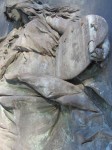
Dr Angela: Who is your favourite dark character? You’re a proponent of the ‘a character doesn’t have to be likeable to be compelling’ school?
I am definitely a proponent of that school! Both the writer and reader sides of me find “compelling” to be a far more important character attribute than “likeability”, and it can arise from many sources: revulsion, terror, fascination, curiosity, to name but a few. In fact, the most likable characters are often not at all compelling – they’re just people you enjoying spending time with – in which case the actual compulsion for the reader to turn the page needs to come from someone or something else entirely.
As for my favourite dark character, that’s a hard one. Patrick Bateman from American  Psycho by Bret Easton Ellis (and, even better, Lunar Park) would rate a mention, mostly because of the constant, exquisite tension between fantasy and reality, between boredom and hyper-arousal, that surrounds him. Also Stevie from Slights by Kaaron Warren, who is a relentlessly brutal (and brutalised) young woman, snarky and psychotic and sharp-edged; not a person you would want to hang around with in real life, but an utterly compelling character to inhabit for a few hundred pages.
Psycho by Bret Easton Ellis (and, even better, Lunar Park) would rate a mention, mostly because of the constant, exquisite tension between fantasy and reality, between boredom and hyper-arousal, that surrounds him. Also Stevie from Slights by Kaaron Warren, who is a relentlessly brutal (and brutalised) young woman, snarky and psychotic and sharp-edged; not a person you would want to hang around with in real life, but an utterly compelling character to inhabit for a few hundred pages.
The truth is, I have many, many favourite dark novels and stories, but not many dark characters spring immediately to mind from them. In the stories I love best, the characters are beset by darkness but not necessarily of the darkness themselves. Or at least, I don’t perceive them that way. I adore Claudia from Interview with a Vampire, for instance. I suppose, being a childlike vampire who routinely seduces, drains and kills her maternally-minded victims, she could be considered a “dark” character – but I don’t see her like that. She is what she has been made to be and behaves as her vampiric nature, and instinct for self-preservation, dictates – the true monsters in that story are the French vampires who murder Claudia, along with her surrogate mother, for being an outsider  ignorant of their rules.
ignorant of their rules.
Darkness, like so much else, is very much in the eye of the beholder.
Dr Lisa: Are there particular horror / dark fiction stories (written by other authors) that have really stuck with you over the years? Ones that still resonate with you long after you finished reading them?
Oh hell, yes – dark fiction resonates more strongly with me than other genres, and seems to leave the most indelible marks. There are far too many beloved titles to offer any kind of complete list here, but let me give you some off the top of my head. Since we’re talking about lasting resonance, I’ll try to limit these to works which I first read at least ten years ago:
We Have Always Lived in the Castle by Shirley Jackson, because of Merricat and her magic which might not be magic, and because of the magnificent high-gothic ending. I loved the uncompromising way in which Jackson tells the story from Merricat’s point of  view – talk about a compelling but not necessarily likeable character! – and how this leaves the reader on a constantly uneven footing in regards to what might be really happening. It’s a brilliant, careful, startling novel.
view – talk about a compelling but not necessarily likeable character! – and how this leaves the reader on a constantly uneven footing in regards to what might be really happening. It’s a brilliant, careful, startling novel.
Skin by Kathe Koja, because of the divine use of language, and because of the characters who come together and fall apart, who tear each apart out of love and ambition. It’s a novel about art and taboo and desire in all its forms, and scenes from it still linger with me. Much of Koja’s fiction tends to haunt me, actually: the self-emaciating dancer from “Pas de Deaux”; the overheard lovers in “Angels in Love”; the brilliant dynamics at play between the characters in Kink. She is an accomplished stylist, an inspiring writer.
And I can’t let a chance to mention Caitlin R. Kiernan go by – one of the best writers of truly weird/macabre fiction working today, and one who is ludicrously under-read. Her short fiction has always left a mark on me – “Spindleshanks” remains one of the few pieces of written work to literally give me nightmares; usually it takes something visual, like film, to stalk me into sleep. Kiernan’s work often treads the liminal and evades absolute explanation, which is exactly the type of fiction I enjoy the most, the type that keeps my brain sifting over a story long after I’ve put the book down. 
I could go on – there’s House of Leaves by Mark Z. Danielewski, many pieces of short fiction of Ramsey Campbell, Weaveworld by Clive Barker, and a whole bunch of stories which would require me to go on an author/title hunt through my anthology shelves – but this is already getting to be an essay-length answer!
Dr Angela: Do you think we, as writers, reach into ourselves to find the darkness? Do you ever feel like you’ve put too much of yourself on the page?
That would be yes to both questions. Research will only take a writer so far when it comes to building characters. At some point, you have to put yourself inside your characters to really bring them to life – you have to feel what they feel, want what they want, fear that they fear, in order to understand them and make them believable. That’s not to suggest that there is necessarily an element of autobiography in everything you write, but the writer does put herself on the page in some form. How can she not? So, yes, if you’re writing about darkness – especially if you’re writing on the side of darkness – then you absolutely have to tap into whatever black little vein resides within you.
 As to putting too much of myself into a story, it’s odd how that works. Occasionally, I find myself angsting over some personal peccadillo or weird habit or embarrassing/distasteful train-of-thought I’ve lent to a character – this is actually me; what if people realise it’s me? Then I look at all of the rest of the made-up stuff in the story, stuff that would be far, far worse if anyone ever thought it an accurate reflection of me personally, and realise that way madness lies. A writer needs to put as much – or as little – of herself into a story as that story requires. Even if it feels like you’ve scraped yourself raw afterwards. Chances are, the only people who will ever guess what That Scene is actually about are the people who already know. That’s what I keep telling myself, anyway
As to putting too much of myself into a story, it’s odd how that works. Occasionally, I find myself angsting over some personal peccadillo or weird habit or embarrassing/distasteful train-of-thought I’ve lent to a character – this is actually me; what if people realise it’s me? Then I look at all of the rest of the made-up stuff in the story, stuff that would be far, far worse if anyone ever thought it an accurate reflection of me personally, and realise that way madness lies. A writer needs to put as much – or as little – of herself into a story as that story requires. Even if it feels like you’ve scraped yourself raw afterwards. Chances are, the only people who will ever guess what That Scene is actually about are the people who already know. That’s what I keep telling myself, anyway
Dr Lisa: The most intriguing / spooky / fascinating / gorgeous cemetery you’ve ever visited is…?
Hmm, that’s really a hard question as I’ve visited and photographed so many of them! I will have to strike the word “spooky” from that list though – I’ve never found cemeteries particularly eerie or frightening. Peaceful and sometimes sad, yes, but not spooky. Mind you, I do usually visit them in daylight hours … 
As for gorgeous and fascinating, I really love the Zentralfriedhof in Vienna, which I visited in the middle of winter one year. The were so many different narrative and figurative gravemarkers (my favourite kind) – plenty of angels, of course, but also knights-at-arms, grieving women and even fantasy-style dwarves. I speak neither Austrian nor German, so I couldn’t read much on the graves themselves, but wandering through a deserted and snow-blanketed cemetery with only a dozen imperious ravens for company was an experience I’ll always cherish.
On that same trip I also came across one of my favourite gravemarkers – a large bas-relief style muse holding an artist’s palette in one hand and a laurel wreath in the other. [See attached photos – feel free to use in the Lair if you like.] There are no wings, so she’s definitely a muse and not an angel and I can only assume the grave she is guarding belonged to a painter. The marker was in the Alter Südlicher Friedhof in Munich and I have unfortunately misplaced the notebook onto which I copied the inscription for later translation. But she is exquisite.
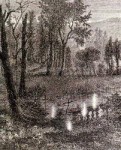 Incidentally, the Alter Südlicher Friedhof is one of Munich’s oldest cemeteries – built in the early 1500’s – and was still in use until about fifty years ago. It’s a woodland cemetery, with lots of trees and footpaths (the interior paths were closed for maintenance when I was there), and a very beautiful place in it’s own right. The locals use it for jogging through, presumably because it’s right in the middle of a dense metropolitan area and serves as a large, peaceful and concrete-free park. Which I find particularly wonderful. The dead deserve company, not isolation.
Incidentally, the Alter Südlicher Friedhof is one of Munich’s oldest cemeteries – built in the early 1500’s – and was still in use until about fifty years ago. It’s a woodland cemetery, with lots of trees and footpaths (the interior paths were closed for maintenance when I was there), and a very beautiful place in it’s own right. The locals use it for jogging through, presumably because it’s right in the middle of a dense metropolitan area and serves as a large, peaceful and concrete-free park. Which I find particularly wonderful. The dead deserve company, not isolation.
Dr Angela: Heathcliff or Edward? Vlad the Impaler or Michael Meyers? Christopher Lee’s Dracula or Bela Lugosi’s?
Firstly, Heathcliff, because even though he is appalling to the women who love him, everyone knows it – including Heathcliff. Also, the only things known to sparkle on the Yorkskire moors are will-o-the-wisps. Who doesn’t love will-o-the-wisps?
Secondly, I’m not a huge fan of the Halloween franchise and find Michael Myers to be a rather bland and predictable monster. (I definitely have more of a soft spot for Freddy Kreuger than for any of his cinematic counterparts.) So I’ll have to go with Vlad because the legends surrounding him truly are monstrous. Plus I’ve lived with an illustration from The Hamlyn Book of Horror in my head since primary school – an infinity of half-naked men impaled on spikes, with Vlad Tepes feasting in the foreground. I stumbled across a tattered, broken-spined, ex-library copy of the book a few years ago on eBay and was both delighted and bemused to find that particular illustration exactly as I remembered it, with  one exception: the illustration is in restrained sepia tones, whereas I recalled it being rather more resplendently sanguine. The mind, she loves to play tricks with the memory!
one exception: the illustration is in restrained sepia tones, whereas I recalled it being rather more resplendently sanguine. The mind, she loves to play tricks with the memory!
Finally, with all due respect to Mr Lee, my heart belongs to Bela Lugosi’s Dracula. His performance has a weird and playful elegance which definitely does justice to the script. “I don’t drink … wine.” Ah, Bela!
Dr Lisa: You’ve found a reverse time capsule: that is, a capsule future Kirstyn has sent back to let you know how things have turned out. What does it look like, and what do you find inside it?
If future Kirstyn knows present Kirstyn well (and I would hope that she does), then the only thing in the time capsule will be a hand-written note that says simply, “You are happy.” Because, honestly, I wouldn’t want to know my future in any more detail than that.
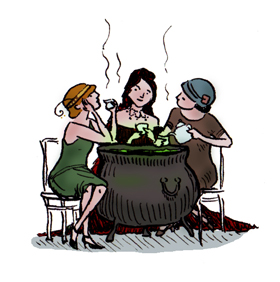 (Of course, whether I would believe such a note is another question entirely. I’m sure future Kirstyn will be even better at mind games than I am!)
(Of course, whether I would believe such a note is another question entirely. I’m sure future Kirstyn will be even better at mind games than I am!)
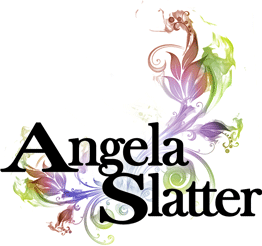

5 Responses to Oops, Your Psychosis is Showing: in the Lair with Kirstyn McDermott